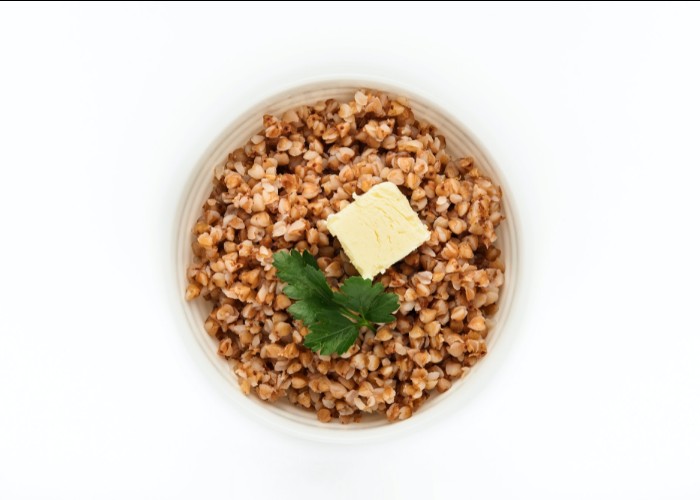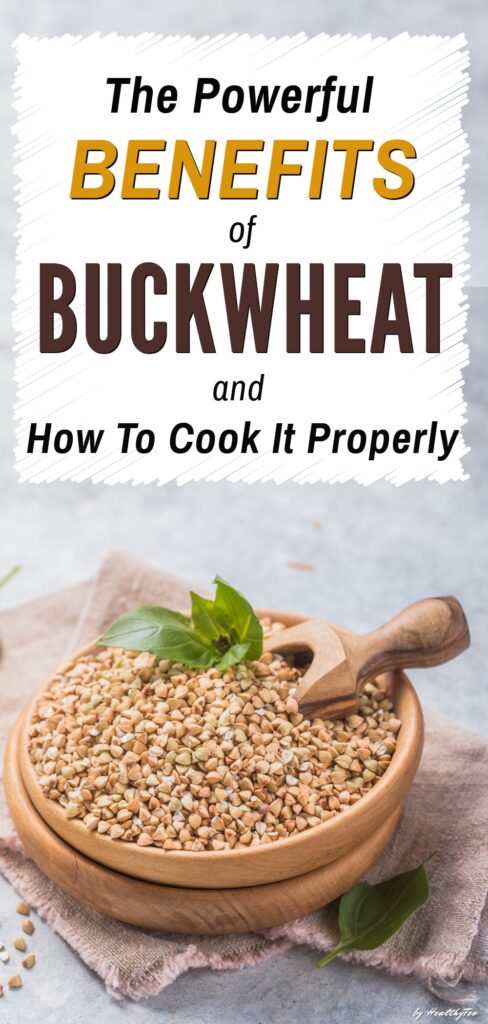Buckwheat nutrition, benefits, and how to eat it
Buckwheat is a gluten-free seed that offers many benefits. Some key benefits of eating buckwheat include supporting heart health, better digestion, helps control blood sugar, a great source of fiber, high-quality protein, minerals, and antioxidants.
Very nutritious and energizing, buckwheat can be used as an alternative to rice, made into porridge, or used in different recipes.
Before we go deeper with the benefits of buckwheat, its nutritional profile, and how to cook it let’s see some interesting facts about this super healthy food:
- Buckwheat has a very short growing season. Harvest usually takes place 10 to 12 weeks after planting.
- Also known as Saracen corn, buckwheat originates from Central Asia, but it can be found around the world today.
- Cultivation of buckwheat started 4.000 years BC.
- Buckwheat is used for the manufacture of highly flavored dark-colored honey.
- Discarded hulls of buckwheat are used as fillers for the pillows.
This post may contain affiliate links, which means we may receive a small commission, at no cost to you, if you make a purchase through a link. For more information, please see our disclosure.
What is buckwheat?
Despite what its name suggests, buckwheat is not wheat or a cereal. Buckwheat belongs to the group of foods known as pseudocereals. Pseudocereals are seeds that we use in a similar way to grains but they are not related to grasses at all.
Pseudocereals are an excellent way to expand your diet giving you access to more flavors, nutrients, and textures. One important thing to mention is that pseudocereals are gluten-free. The most popular types of pseudocereals are chia seeds, amaranth, millet, quinoa.
There are many varieties of buckwheat but the most common are Tartary buckwheat (Fagopyrum tartaricum) and common buckwheat (Fagopyrum esculentum).
The hulled seeds of the buckwheat plant are called groats and they have pale tan to dark brown and have a subtle flavor that becomes earthy and nutty when roasted.
The roasted variety is known as kasha and is a staple food in Eastern Europe.

Today, buckwheat is a favorite among gluten-free and plant-based eaters alike since it provides a high source of vitamins, amino acids, minerals, antioxidants – all with relatively few calories, practically no fat, and no gluten.
Buckwheat nutrition facts
According to the USDA one cup ( 168 grams ) of cooked, roasted buckwheat groats contains approximately:
- Calories: 155
- Carbohydrates: 33.5 grams
- Protein: 5.7 grams
- Fat: 1 gram
- Fiber: 4.54 grams
- Manganese: 30% DV
- Magnesium: 21% DV
- Phosphorus: 12% DV
- Zinc: 7% DV
- Iron: 7% DV
Buckwheat also contains vitamins including: thiamin, riboflavin, niacin, folate, vitamin K, vitamin B-6.
Carbs
Buckwheat contains plenty of carbs. Carbs make up about 20% of boiled groats by weight. They come in the form of starch which is carbs’ primary storage form in plants. There are 34 grams of carbs in one cup of cooked buckwheat groats.
Fiber
The amount of fiber by weight makes up 2.7% of boiled groats and is mainly composed of cellulose and lignin. It is mainly concentrated in the husk which coats the groat. The husk also contains resistant starch, which is resistant to digestion and is also categorized as fiber.
Resistant starch is fermented by your gut bacteria. These bacteria produce short-chain fatty acids such as butyrate. Butyrate and other short-chain fatty acids serve as nutrition for the cells living in your colon, improving gut health.
Protein
Buckwheat contains high-quality protein that delivers all of the essential amino acids. It’s particularly rich in the amino acids lysine and arginine.
As we mentioned before, like other pseudocereals buckwheat is gluten-free and is suitable for people with gluten intolerance.
Vitamins and minerals
The most abundant minerals in buckwheat are manganese, copper, magnesium, iron, phosphorus. Buckwheat contains more minerals than many common kinds of cereal such as corn, wheat, and rice.
These minerals in cooked buckwheat groats are well-absorbed, due to buckwheats’ low content of phytic acid. Phytic acid is a common inhibitor of mineral absorption found in seeds and grains.
Antioxidant plant compounds
Buckwheat provides more antioxidants than many other grains such as wheat, oats, rye, and barley. These plant compounds are responsible for many of the buckwheat benefits. The main buckwheat plant compounds are rutin, quercetin, vitexin, D-chiro-inositol.
Health benefits of buckwheat
Now, let’s see what are the benefits of buckwheat!
Boosting heart health
Buckwheat contains many heart-healthy compounds like magnesium, copper, fiber, rutin, and certain proteins. Rutin is one of the most important flavonoids found in these seeds.
Rutin may cut the risk of heart disease by preventing the formation of blood clots and decreasing inflammation and blood pressure. Rutin also increases levels of good cholesterol (HDL) which further reduces the chances of cardiovascular disease.
The relationship between buckwheat and oats intake to cardiovascular disease risk factors was studied in 850 Chinese adults.
The results of this comparative study showed that buckwheat intake is associated with lower blood pressure and an improved blood lipid profile. This includes higher levels of HDL-good cholesterol and lower levels of LDL-bad cholesterol.
The American Heart Association recommends that at least half of the grains in a person’s diet should be whole grains. People who follow gluten-free diets consume lower amounts of whole grains.
This means that they miss out on the health benefits they provide. Including buckwheat in the diet as an alternative to the whole grains that contain gluten can deliver these benefits.
May help control blood sugar
Buckwheat has a low to moderate glycemic index GI – a measure of how quickly a food raises blood sugar after a meal. The carbohydrates found in its nutrition are absorbed into the bloodstream slowly. This helps you to feel full and supports sustainable energy.
It is a rich source of D-chiro inositol, a compound that reduces blood sugar. This is supported by animal studies. Animal research has found that buckwheat has a positive effect on insulin and blood glucose in mice with diabetes on a high-glucose diet.
However, it is not clear whether these findings extend to humans with diabetes.
Further, a study comparing the buckwheat eating region of Mongolia to the region where buckwheat is not consumed found that populations who eat buckwheat had almost 17% lower fasting blood sugar levels.
The beneficial polyphenols that buckwheat contains and the low glycemic index are two reasons for people with diabetes to consider adding these seeds to their grocery list.
Improving digestion
Buckwheat is a good source of fiber and niacin which makes it a great choice for digestive health, another from many buckwheat benefits. Fiber helps to fill you up and helps food move through the digestive tract. This is important for regular bowel movements.
Further, one cup of buckwheat contains 1.58 milligrams of the recommended 14 to 16 milligrams of niacin (vitamin B3) for adults. Niacin is very important for converting carbohydrates, proteins, and fat into energy for the body’s cells to use.
Great source of highly digestible protein
Buckwheat contains more protein than any form of rice, wheat, or corn. In every 100 grams, it contains 11-14 grams of protein which is higher than most whole grains. As we mentioned before it contains very important, essential amino acids called lysine and arginine.
These specific amino acids are not found in many other cereals or whole grains. Getting them from these seeds ensures you cover the full range of essential proteins your body needs.
High-quality proteins are important for your body. Food containing complete proteins not only replaces the need to eat red meat but also gets the benefits from those proteins faster. If you are a vegan or vegetarian, buckwheat is a food that you must include in your diet.
Why these proteins are so important? They help you feel full faster, provide an extra energy boost and studies have shown that they increase cognitive ability.
Gluten-free
Pure buckwheat is gluten-free. It is safe for anyone with celiac disease or gluten sensitivity. It can stand in place of gluten-containing grains like barley, wheat, rye, and oats. Buckwheat is also used for making products that are labeled gluten-free.
You should not assume that product is gluten-free just because it contains buckwheat. Always read the label for gluten-free certification.
Potential side effects
When eaten in moderation buckwheat is generally safe to consume and should not cause side effects in most people. However, it is possible for buckwheat to cause a reaction in people with buckwheat allergies.
Reports of buckwheat allergies are uncommon in the U.S. But, you should avoid it if it causes any type of skin rash, serious indigestion, itching, runny nose, swelling. If you are trying buckwheat for the first time and you experience some of these symptoms, seek medical help immediately.
How to cook buckwheat

Buckwheat is used in many different food products – from granola to Japanese soba noodles. In the U.S. popular buckwheat recipes are those made with buckwheat flour, like bread, cookies, muffins, and other snacks that are high in protein and fiber, but gluten-free.
When you use buckwheat flour as an alternative to traditional flour you need to adjust the recipe proportions. If not adjusted its high fiber content can make baked goods come out more rough or dry.
Every time you use buckwheat flour to get the right texture, follow a recipe that specifically calls for buckwheat flour.
Buckwheat has a nutty flavor. Cooked buckwheat groats are similar in taste and consistency to steel-cut oatmeal. Here is the simplest way to cook buckwheat ( from dried oats):
- Rinse and drain buckwheat well. In a small saucepan combine 1 cup buckwheat groats with 1 3/4 cups water, 1 tablespoon unsalted butter, and 1/2 tablespoon salt.
- Bring to a simmer then cover with a tight-fitting lid and simmer on low for 18-20 minutes.
- Remove from the heat and let for the buckwheat to rest for 10 minutes. Fluff with a fork and serve. Add more butter if desired, but avoid stirring too much to prevent from mushing cooked buckwheat.
Buckwheat can also be added to stir-fries or served as a side dish. It pairs really well with broccoli and salmon.
Further, you can use it as a base under your favorite protein with a side of roasted vegetables of choice. Another suggestion is to use buckwheat instead of croutons for your salad for an extra nutrient punch.
It is interesting to mention that buckwheat is part of the top 20 sirtfoods. These foods are the base of the Sirtfood Diet that the famous singer-songwriter Adele was following to lose weight.
If you’ve never cooked meals with buckwheat here are 19 recipes that may help you to incorporate buckwheat into your daily diet!
Frequently asked questions about buckwheat
Is buckwheat keto-friendly?
Buckwheat is not a low-carb food. In one cup of buckwheat (168 g) there are 33.5 grams of carbohydrates. So, buckwheat is not keto-friendly and is not going to fit in a keto diet.
Can you eat buckwheat raw?
Buckwheat groats can be eaten raw. However, they need to be soaked first. Raw buckwheat groats are pretty hard to chew. Do it is best to soak, rinse and strain buckwheat groats before using them.
All of these will also make sure raw buckwheat groats are better digested and taste much better than not-soaked raw buckwheat.
Is buckwheat healthier than rice?
Buckwheat has higher essential amino acids including lysine and arginine and contains more protein. Also, it is gluten-free and safe for people with gluten allergies.
How much buckwheat should I eat a day?
As a part of a balanced diet, a healthy serving of buckwheat would be 1/2 cup or 84 grams per day.

Final thoughts about the benefits of eating buckwheat
Buckwheat is a gluten-free pseudocereal. It is a great source of high-quality protein, fiber, minerals, and antioxidants. The benefits of buckwheat include supporting heart health, improved digestion may help control blood sugar, and is an excellent food choice for people with gluten sensitivity.
It can be used for making buckwheat porridge, gluten-free baked goods, stir-fries, soups, salads, and more. According to all mentioned above, it is good to add buckwheat to your diet!
Disclaimer: While we have looked into the research on the health benefits of this food, this is only for informational purposes and should not be construed as medical advice. Those with health-related questions should seek the advice of a medical professional.




